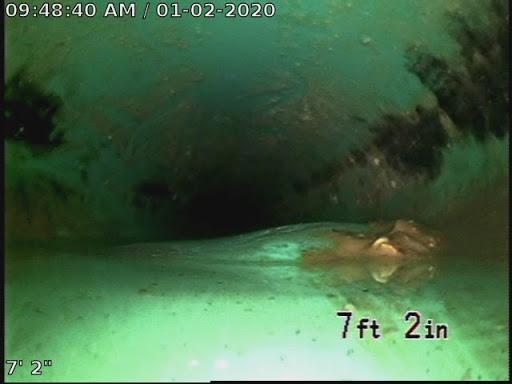Sewer Inspections Part 2
Welcome to part 2 of our sewer camera blog. We are going to share some potential issues you might find while inspecting a sewer line. We’ll talk about the what, where, why and how of each of them, so let’s dive right in!
Here are a few common issues we find in drain lines:
Roots: Generally roots grow through pipes that have cracks and/or breaks in them. They don’t even have to be on your property to grow quite long lengths to get water. Here is an interesting read about it https://www.deeproot.com/blog/blog-entries/how-wide-do-tree-roots-spread. Roots are opportunistic so if they want it they will get it from the easiest source first, which a lot of times is a leaky sewer line. Here are a few examples of what tree roots look like in sewer lines:


Scale/debris: If your home or business was built earlier than the 1980’s there is a good chance you have cast iron pipe. Cast iron and galvanized pipes tend to rust inside and that rust creates a rough surface which causes debris to build up like grease, hard water, food waste, and soap scum. This debris will stick to the sides, causing mini dams in the pipe, which can then collect more debris, leading to a back up.

Low spots or bellies: These are spots in the drain lines that are either flat for a segment or have a loss of slope, meaning the pipe is no longer going at a downward slope but is actually headed upwards. The line works like a slip and slide: everything goes down until it hits the standing water, which stops its progression to the city main. Here is a link to a short video of a sewer inspection going through one: https://youtu.be/VefIWZRMMHA Notice the amount of build up around it. That standing water allows the things that are normally a liquid, such as grease or other food waste, to settle out and stick to the pipe.
Pipe breaks, misaligned pipe or missing pipe: Pipe breaks, misalignment or cracking generally is caused by poor backfill, compaction or a change of use above the pipe. We see new homes, old homes, and everything in between with issues. One of our favorite sayings is “never say never” that one time you do you will find what you didn’t think could happen has happened. We find piping that is damaged in backfilling or someone put a rock under a pipe to hold it up and now that rock has broken through the line.
Example of missing pipe:

A rock was buried under the pipe which caused a bump in the pipe and a belly that holds water:

Cracks in clay pipe on top of pipe:

Orangeburg pipe: This type of pipe is made of a wood pulp covered tar type coating. Here is some history behind it: https://en.wikipedia.org/wiki/Orangeburg_pipe The pipe worked great for many years, but what no one knew was that it would absorb the water being discharged down it, eventually causing it to get soft, bubble and collapse. Here is a short video showing the bubbling and partial collapse of the pipe. https://youtu.be/ow5a2HDoeUE
Notice how it goes from being round to not very quickly. Some other things to notice are the smaller bubble before the large one.
Catch up with us in 2 weeks for our 3rd installment on technologies that can fix these issues without making a huge mess.
